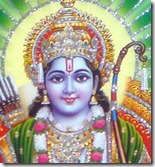 “Just as within the earth is found every kind of seed and within the sky live all the stars, Tulsidas knows that Shri Rama’s holy name is the reservoir of all dharma.” (Dohavali, 29) “Just as within the earth is found every kind of seed and within the sky live all the stars, Tulsidas knows that Shri Rama’s holy name is the reservoir of all dharma.” (Dohavali, 29)jathā bhūmi saba bījamaya nakhata nivāsa akāsa | rāma nāma saba dharamamaya jānata tulasīdāsa || Where should we start in our spiritual journey? Say that we are curious about the truths of life, the reason for our existence, which direction we should go in, what determines pious action and what is considered sinful - where do we go to find the answers? Should we start out small, or is there a singular process that can reveal everything? In this age of Kali, where dharma, or religiosity, is conspicuous by its absence, and quarrel and hypocrisy are commonplace, following the bottom up approach is very difficult. To understand the nature of the soul, appreciate the matter outside, realize the common bond shared between all forms of life, and then finally marvel in the wonder, beauty and benevolence of the almighty Creator and recognize His transcendentally blissful form is a very difficult sequence of steps to follow. If we choose one special course, however, we’ll soon realize that in just one aspect of the Supreme Absolute Truth can be found all the others, both material and spiritual. Thus not only is this method of spiritual practice complete in every way, but it also serves as both the starting and end points. 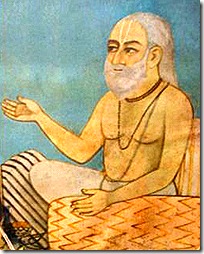 To understand the distinctions more clearly, we can look to the first two examples given in the above quoted verse from the Dohavali, or collection of couplets, of Goswami Tulsidas. The wonderfully sweet, kind, humble and exquisitely learned poet first says that within the earth are found all seeds. Let’s pretend that we are starting our knowledge gathering efforts from scratch. This isn’t that difficult to imagine, as during infancy we are completely helpless and ignorant. The young child is actually no smarter than an animal, and in many cases is less intelligent, as adult aged animals know how to feed themselves, sleep on time, reproduce, and adequately defend themselves from attack. To understand the distinctions more clearly, we can look to the first two examples given in the above quoted verse from the Dohavali, or collection of couplets, of Goswami Tulsidas. The wonderfully sweet, kind, humble and exquisitely learned poet first says that within the earth are found all seeds. Let’s pretend that we are starting our knowledge gathering efforts from scratch. This isn’t that difficult to imagine, as during infancy we are completely helpless and ignorant. The young child is actually no smarter than an animal, and in many cases is less intelligent, as adult aged animals know how to feed themselves, sleep on time, reproduce, and adequately defend themselves from attack.Let’s say that as we mature from infancy into childhood, we start to appreciate the surrounding environment. The first things we might notice are the wonderful trees and plants in the garden in the backyard. We might ask our father, “Dad, where did these plants come from? Where did these tomatoes that we eat every night appear from magically, all of a sudden?” Our father will then walk us through the entire process, how a seed is planted in the soil, and how through careful attention and consideration it eventually fructifies and grows tomatoes. This wonder of nature is certainly easy to overlook, as it is truly a miracle that food items can sprout from the tiniest of seeds.  Understanding how just one plant grows serves as a substantial foundational base, but then we might also notice other plants. Again, we’ll ask our dad, “Father, wherefrom did these other plants come? Do they grow in the same way as the seeds that produced the tomatoes?” This time we will witness the growth cycles again, note down the results of the experiment in our mind, and then increase our appreciation for the seeds. Gradually, as we start to add to our knowledge base, we may start to appreciate more and more plants and the overall miracle of life. Understanding how just one plant grows serves as a substantial foundational base, but then we might also notice other plants. Again, we’ll ask our dad, “Father, wherefrom did these other plants come? Do they grow in the same way as the seeds that produced the tomatoes?” This time we will witness the growth cycles again, note down the results of the experiment in our mind, and then increase our appreciation for the seeds. Gradually, as we start to add to our knowledge base, we may start to appreciate more and more plants and the overall miracle of life.A similar appreciation can come from watching the stars in the sky and the workings of the sun. During the morning the sun rises and gradually warms up the earth, causing plants to grow and human beings to have the benefit of natural light. When the sun sets at night, the heat and light vanish, thus bringing a depressing condition. Through daily observation, the young child will slowly but surely start to appreciate the wonderful sun and its benevolence. The moon can be similarly noticed and appreciated for the functions it performs daily, which don’t require any outside intervention. The moon provides light at night, supplies the juice of life to the vegetables growing in the ground, and influences the tides of the oceans. Thus the moon and the sun can be both appreciated through seeing how they operate.
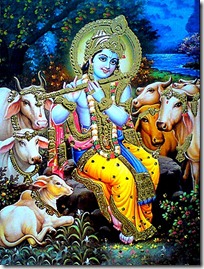 In both instances, full appreciation is eventually reached, but through a step-by-step process. Eventually, if we study all the plants that grow from the ground and all the stars situated in the sky, we’ll see that the earth and the sky are the abodes of both miracles of material existence. If we would have first studied the earth and the entire sky, then we would have automatically learned about the different plants and stars. The earth and sky are actually more important because they are reservoirs, the holding places, for the individual miracles that were noticed. In both instances, full appreciation is eventually reached, but through a step-by-step process. Eventually, if we study all the plants that grow from the ground and all the stars situated in the sky, we’ll see that the earth and the sky are the abodes of both miracles of material existence. If we would have first studied the earth and the entire sky, then we would have automatically learned about the different plants and stars. The earth and sky are actually more important because they are reservoirs, the holding places, for the individual miracles that were noticed.Expanding the scope of vision out fully, it is seen that all dharmas, or systems of religiosity, are held nicely within the reservoir of pleasure and energy, the Supreme Lord, who is known by many names in the various spiritual traditions around the world. In the Vedic tradition, He is often addressed as Lord Rama, for this not only points to His avatara as a pious prince who appeared on earth during the Treta Yuga, but it also describes God’s ability to provide transcendental pleasure to His devotees. Shri Rama is the Supreme Personality of Godhead, and as such, in Him can be found every religious process and every aspect of life. 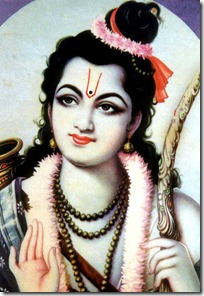 Why is it important to know that Rama holds the many systems of religion within Him? Similar to how our appreciation increased when we learned more about the earth and the sky, if we know a little bit more about the object of all religious sacrifice, penance, austerity, charity and dedication, we will be able to understand and appreciate the individual aspects of spiritual life more fully. Rama is not a sectarian figure; He is the Supreme Lord for all of humanity. Though there are various non-different forms of the same original person, Tulsidas especially worships God in His form of Shri Ramachandra, who carries a bow and arrow in His hands and promises to always protect the surrendered souls. Why is it important to know that Rama holds the many systems of religion within Him? Similar to how our appreciation increased when we learned more about the earth and the sky, if we know a little bit more about the object of all religious sacrifice, penance, austerity, charity and dedication, we will be able to understand and appreciate the individual aspects of spiritual life more fully. Rama is not a sectarian figure; He is the Supreme Lord for all of humanity. Though there are various non-different forms of the same original person, Tulsidas especially worships God in His form of Shri Ramachandra, who carries a bow and arrow in His hands and promises to always protect the surrendered souls.In spiritual life especially there are divergences in the specific practices adopted, with some worshiping through meditation, others studying the difference between matter and spirit, and some even praying to an abstract entity to remove their distresses. If we were to practice every single one of these processes, we could maybe gain a greater appreciation for the Supreme Person who not only distributes the results of sacrifice, but serves as the creator of every spiritual tradition known the world over. 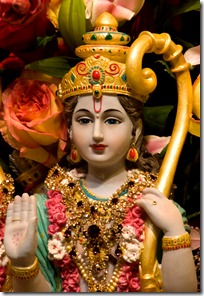 There is an easier method, however, for understanding everything. At its root meaning, dharma is the essential characteristic of something, and in the religious sense it is meant to apply to the soul, which is the individual functioning unit within every living being. To maintain the essential characteristic within, to bring it to the forefront of consciousness and activity, a set of rules and regulations is required, a recommended way of life aimed at evoking the primary properties of the soul. This set of principles can also be described using the word “dharma”; hence the common English translation for dharma being “religion”. In its constitutional position, the soul is blissful, eternal, knowledgeable and most of all, a lover of God. One who loves must engage in some service; so when the soul loves God it must have a series of activities aimed at keeping that bond of affection intact. There is an easier method, however, for understanding everything. At its root meaning, dharma is the essential characteristic of something, and in the religious sense it is meant to apply to the soul, which is the individual functioning unit within every living being. To maintain the essential characteristic within, to bring it to the forefront of consciousness and activity, a set of rules and regulations is required, a recommended way of life aimed at evoking the primary properties of the soul. This set of principles can also be described using the word “dharma”; hence the common English translation for dharma being “religion”. In its constitutional position, the soul is blissful, eternal, knowledgeable and most of all, a lover of God. One who loves must engage in some service; so when the soul loves God it must have a series of activities aimed at keeping that bond of affection intact.For the conditioned souls roaming the earth that is full of seeds and appreciating the sky with its numerous stars, knowledge of the relationship to God and the inherent characteristics of spirit remains unknown. Therefore the original dharma, which is described assanatana, or eternal, is needed. In the absence of deference to dharma, mankind is no different from the animal, for no other species has the intelligence capacity to even understand the need for abiding by the rules governing right and wrong, piety and sin, virtue and vice. Only the human being can understand these concepts, and only through dharma can they find the proper path in life. 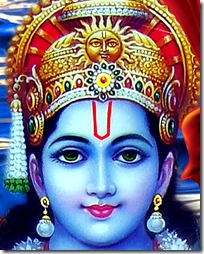 Tulsidas declares that in Rama’s name can be found all dharma, or systems of religiosity. This is indeed true, as the name of Rama automatically brings His audience, thus allowing the conditioned souls to directly approach God right away. Chanting the names of the Lord found in the maha-mantra, “Hare Krishna Hare Krishna, Krishna Krishna, Hare Hare, Hare Rama Hare Rama, Rama Rama, Hare Hare”, forms the cornerstone of the engagement known as bhakti-yoga, or devotional service. Only in the material realm, where other disciplines besides divine love can be practiced, do the terms “bhakti” and “dharma” even apply. When in the pure state, the soul has no other business but constant service to the Lord and enjoyment of His company. Just as darkness only exists when light is absent, the different processes of religion are only introduced when the highest engagement of bhakti is not practiced. Tulsidas declares that in Rama’s name can be found all dharma, or systems of religiosity. This is indeed true, as the name of Rama automatically brings His audience, thus allowing the conditioned souls to directly approach God right away. Chanting the names of the Lord found in the maha-mantra, “Hare Krishna Hare Krishna, Krishna Krishna, Hare Hare, Hare Rama Hare Rama, Rama Rama, Hare Hare”, forms the cornerstone of the engagement known as bhakti-yoga, or devotional service. Only in the material realm, where other disciplines besides divine love can be practiced, do the terms “bhakti” and “dharma” even apply. When in the pure state, the soul has no other business but constant service to the Lord and enjoyment of His company. Just as darkness only exists when light is absent, the different processes of religion are only introduced when the highest engagement of bhakti is not practiced.The transcendentalists known as monists, or those who believe Rama to be simply a manifestation of the Absolute Truth known as Brahman, of which we are all part, take bhakti to be another process of dharma aimed at bringing self-realization. In reality, bhakti is the pinnacle of religious practice, the storehouse of all other engagements. This is the point put forth by Tulsidas, as the name of Rama is the complete whole, not simply an aspect of religion or a manifestation of the Truth. Those who don’t know Rama’s name or don’t understand the true dharma of the soul will speculate that life is about merging into the Absolute Truth and negating material action, but these are just two tools that can help in reaching the bhakti platform, a state which can be directly found by chanting Rama’s name with love and devotion.
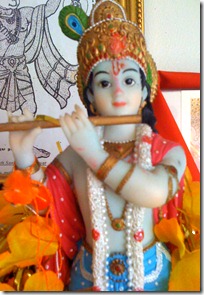 All aspects of religion are similarly just tools meant to lead to bhakti. Let’s say that we take bhakti to be just a method of self-realization aimed at removing one’s attachment to matter and the senses. When the state of Brahman realization, or brahma-bhutah, is attained, then what? The soul is inclined towards activity, so even when it no longer desires association with material life and deference to karma and sense demands, it still must have something to do. Therefore even brahma-bhutah represents an imperfect state, a platform which must lead to something better. All aspects of religion are similarly just tools meant to lead to bhakti. Let’s say that we take bhakti to be just a method of self-realization aimed at removing one’s attachment to matter and the senses. When the state of Brahman realization, or brahma-bhutah, is attained, then what? The soul is inclined towards activity, so even when it no longer desires association with material life and deference to karma and sense demands, it still must have something to do. Therefore even brahma-bhutah represents an imperfect state, a platform which must lead to something better.In the Bhagavad-gita, Lord Krishna, the very same Shri Rama but in a different form, states that once the yogi attains the state of Brahman realization, He can take to worshiping the Supreme Lord in love and devotion. The same principle applies to meditational yoga, fruitive activity, or any other non-bhakti discipline. Dharma can involve more granular procedures depending on the scope of activity. For instance, pious behaviors such as telling the truth, being kind to others, sharing your wealth, helping the poor, etc. are smaller forms of religion that descend from the highest practice of loving God. We can accept the individual processes and maybe one day come to the final realization of our relationship with the Supreme Lord as His part and parcel fragments made to always be in His company, but by chanting the non-different names of God with love and devotion, all necessary knowledge can be acquired. Moreover, the benefits of every other religious practice can be found as well. Thus the bhakta, or devotee, is never a loser. Understanding the nature of the earth will give us more appreciation for the seeds that come out of it, and studying the sky can help us better understand the stars that remain comfortably housed within. Similarly, chanting the holy name of the Lord through love and devotion brings about real God consciousness, where the many processes of religion are simultaneously understood properly. 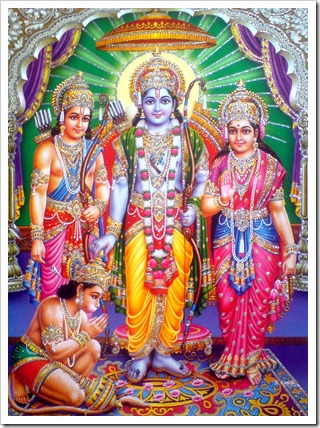 Indeed, devotees can explain every aspect of life, material or spiritual, through its relation to God. This is how the famous acharyas and saints have produced seemingly endless volumes of literature glorifying the Lord and devotion to Him. The name of Rama opens our transcendental eyes and allows us to have a clear vision. Moreover, the bhakti platform is an eternal one, bringing an attitude of undying love and affection aimed at everyone’s dearmost friend, the Supreme Lord. Just as the name of Rama safely holds the different systems of dharma known to man, in the devotee of Rama can be found the fruits and rewards of all religious practice, namely every beneficial quality and attribute one can acquire. Therefore the dust of the lotus feet of a Vaishnava, the devotee of God’s personal forms, is the greatest benediction in life, as the dedication to chanting exhibited by the bhakta serves as the best example to follow. Indeed, devotees can explain every aspect of life, material or spiritual, through its relation to God. This is how the famous acharyas and saints have produced seemingly endless volumes of literature glorifying the Lord and devotion to Him. The name of Rama opens our transcendental eyes and allows us to have a clear vision. Moreover, the bhakti platform is an eternal one, bringing an attitude of undying love and affection aimed at everyone’s dearmost friend, the Supreme Lord. Just as the name of Rama safely holds the different systems of dharma known to man, in the devotee of Rama can be found the fruits and rewards of all religious practice, namely every beneficial quality and attribute one can acquire. Therefore the dust of the lotus feet of a Vaishnava, the devotee of God’s personal forms, is the greatest benediction in life, as the dedication to chanting exhibited by the bhakta serves as the best example to follow. |
Search This Blog
Thursday, August 4, 2011
The Starting Point
Subscribe to:
Post Comments (Atom)
No comments:
Post a Comment